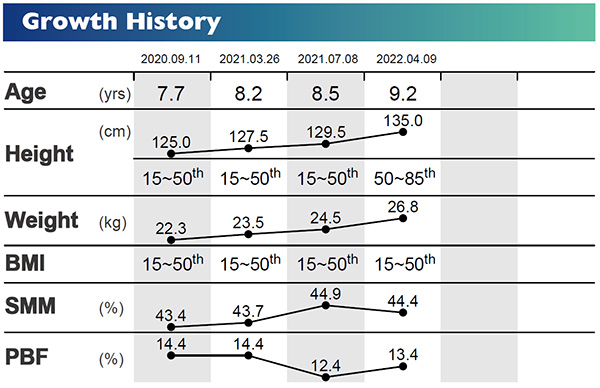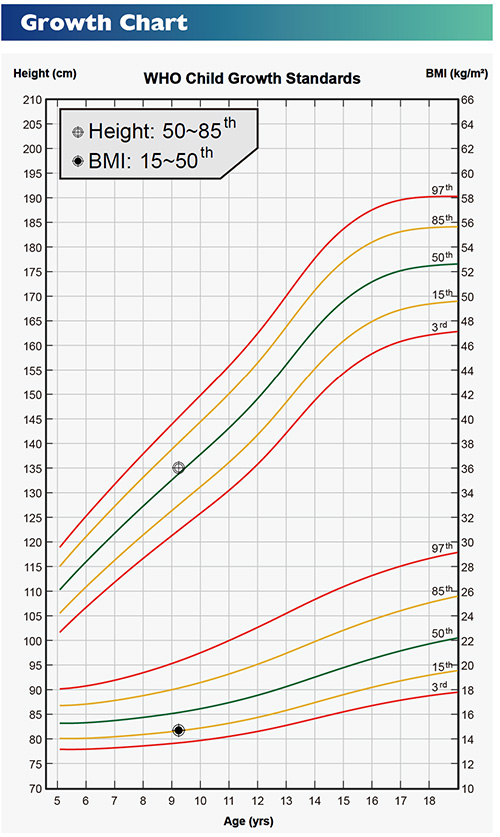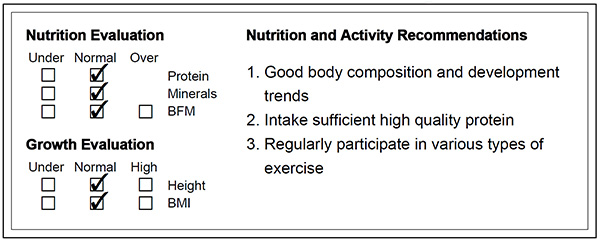The Charder MA601 and MA801 Body Composition Analyzers can output a specialized child result sheet to provide pediatricians with a comprehensive growth evaluation from childhood to adolescence, going beyond traditional measurements like weight and height.
Why is Body Composition Analysis important?
Traditionally, measurements like weight and height have been used to assess growth for children, comparing results with standardized growth charts. However, weight in particular needs to be interpreted carefully, because it does not distinguish between muscle and fat. In less than 50 seconds, a professional Charder device can complete a full scan, making it easier to evaluate growth trends in more detail, and create personalized nutrition and activity recommendations.
Muscle-Fat Analysis
Weight will always be an important indicator of a child's growth, but measurement of muscle and fat provides crucial insight regarding growth trends, and if adjustments are recommended to the child's diet and activities. Physiological changes such as height can be observed relatively easily, but sufficient nutrition is critical for proper muscle development and may not be as easily observed from outward appearance.
Obesity Analysis
Percent Body Fat, Body Mass Index, and Waist Height Ratio is organized into Under, Normal, Over, and Obese categories. By providing body composition measures in addition to BMI, pediatricians can more accurately interpret weight changes during growth, to see if it's caused by balanced muscle and fat development, or excessive increase of fat. As other tools for measurement of body fat such as Dual Energy X-Ray Absorptiometry (DXA) are not recommended for children due to radiation exposure, BIA devices such as the MA601 and MA801 are a safe and non-invasive choice. As childhood obesity becomes increasingly prevalent, identifying trends towards obesity by measuring frequently is more important than before!
Growth History
Because the BIA measurement technology used by Charder's Body Composition Analyzers is safe and non-invasive, measurements can be conducted regularly to evaluate growth in a cost-effective manner. By selecting the same user ID prior to measurement, growth trends can be tracked automatically (Height, Weight, BMI, Skeletal Muscle Mass, and percentiles), and the child's height and BMI will be compared with their peers, allowing pediatricians to observe positive or negative trends for each individual quickly.
Growth Chart
The Child Result Sheet provides a visual growth chart to further illustrate what the typical growth rate for children and adolescents is, and where the child's results land in comparison to others. Results in the 3rd percentile are a potential sign of malnutrition or delayed growth, and can be an important cautionary sign to conduct a more detailed health check-up.
Evaluation & Recommendations
Based on body composition and growth results, the Child Result Sheet will provide an evaluation and recommendations for nutrition and exercise. Results should be considered a general reading, and not for diagnostic purposes. This is intended to provide a general guideline, and not a replacement for professional advice.
Research Information
Muscle and fat is important for evaluation of growth, but two people with the exact same weight, muscle, fat, and height may not be equally healthy! Phase Angle can be utilized effectively to discern differences in health status; a higher phase angle generally correlates with better health, and a lower phase angle can be a sign of weaker cells or malnutrition.
Next up is Basal Metabolic Rate (BMR) - how much energy the body uses each day before taking into account activity level. Although there are many online calculators that can calculate BMR (generally relying on a combination of weight, height, and gender), muscle mass is a key variable that affects how high your BMR is moreso than weight. In addition to muscle mass, Charder's BMR calculation also takes into account the child's age, making it more accurate and therefore useful for nutritionists.
If you know how much energy a person uses each day, it becomes much easier to establish a recommended nutrition and activity program.
Health is a complex and important topic, and establishing good habits from an early age can create a good foundation for later in life. Using quantifiable data, parents and pediatricians can observe growth objectively, helping to build a healthy and nurturing environment.
(NOTE: if your device has not been updated to the latest version, it might not support the child result sheet yet - please contact your Charder distributor for upgrade details)











